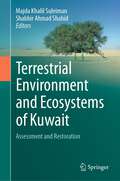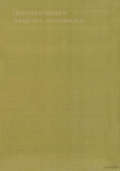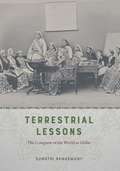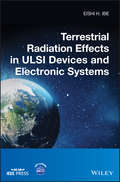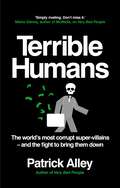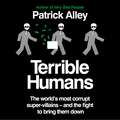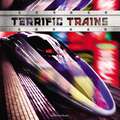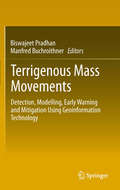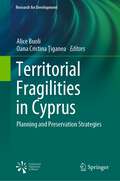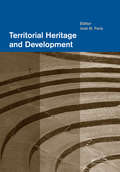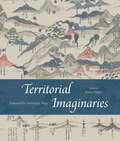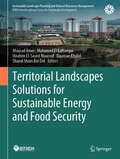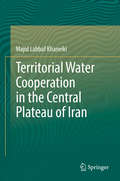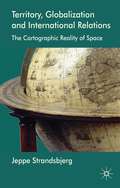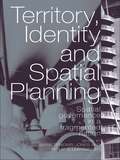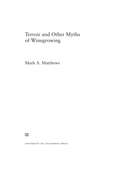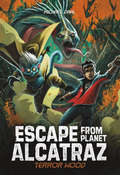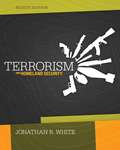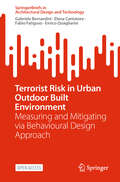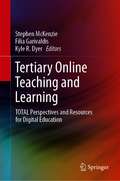- Table View
- List View
Terrestrial Environment and Ecosystems of Kuwait: Assessment and Restoration
by Majda Khalil Suleiman Shabbir Ahmad ShahidThis book is an outcome of collaborative efforts of a multidisciplinary team of scientists. The core objective of this book is to provide cross-sectoral information on the different aspects of the terrestrial environment and ecosystems of Kuwait. The book will be considered as a ready source of information for those seeking information on the terrestrial environment and ecosystems, assessment and restoration, as well as sustainable uses and management. In spite of Kuwait’s hyper-arid environment, it is rich in natural resources including a wide range of native plants, animal species, different habitats, protected areas, diversified soils and water and oil resources. While the desert of Kuwait constitutes various features, such as sand sheet, sand dunes, nebkhas, inland and coastal sabkhas, rock outcrop, wadis and farming areas, it is rich in flora and fauna (native plants, mammals, birds, reptiles, etc.). Due to changing climate, deserts of Kuwait as well as other countries are under severe threat of degradation and the degradation may be irreversible. To realize these impacts, an effort is being made to provide a ready source of information to highlight the potential threats to the terrestrial ecosystems and formulate adaptation and mitigation strategies for long-term ecosystems services in Kuwait as well as other countries located in a desert environment, such as Gulf Cooperation Council Countries, Africa and countries in the Arab region. The book includes sixteen chapters covering multidiscipline subjects (such as natural resources, climate and climate change, geographical features, terrestrial habitats, ecosystems and threats, water and soil resources, agriculture, food security, water-energy-food-climate nexus, green-grey-blue water footprints of various crops, etc.). Thus, this book is a unique resource that provides the latest scientific information in a single volume.
Terrestrial Isopod Biology (Advances In Crustacean Research Ser. #Vol. 9)
by A.M. AlikhanThis text contains the papers of a meeting on American isopods, the only crustacean group with representatives in all terrestrial ecosystems ranging from the sea shore to the desert. Due to such adaptibility, this group can be seen as a model for the successful transition on land. The text deals with two main subjects: the effects of stressful conditions on the individual animal as reflected by its survival or by the disruption of its normal reproductive pattern; and the distribution of the isopods and their selection of microhabitat.
Terrestrial Lessons: The Conquest of the World as Globe
by Sumathi RamaswamyWhy and how do debates about the form and disposition of our Earth shape enlightened subjectivity and secular worldliness in colonial modernity? Sumathi Ramaswamy explores this question for British India with the aid of the terrestrial globe, which since the sixteenth century has circulated as a worldly symbol, a scientific instrument, and not least an educational tool for inculcating planetary consciousness. In Terrestrial Lessons, Ramaswamy provides the first in-depth analysis of the globe’s history in and impact on the Indian subcontinent during the colonial era and its aftermath. Drawing on a wide array of archival sources, she delineates its transformation from a thing of distinction possessed by elite men into that mass-produced commodity used in classrooms worldwide—the humble school globe. Traversing the length and breadth of British India, Terrestrial Lessons is an unconventional history of this master object of pedagogical modernity that will fascinate historians of cartography, science, and Asian studies.
Terrestrial Radiation Effects in ULSI Devices and Electronic Systems (Wiley - IEEE)
by Eishi H. IbeThis book provides the reader with knowledge on a wide variety of radiation fields and their effects on the electronic devices and systems. The author covers faults and failures in ULSI devices induced by a wide variety of radiation fields, including electrons, alpha-rays, muons, gamma rays, neutrons and heavy ions. Readers will learn how to make numerical models from physical insights, to determine the kind of mathematical approaches that should be implemented to analyze radiation effects. A wide variety of prediction, detection, characterization and mitigation techniques against soft-errors are reviewed and discussed. The author shows how to model sophisticated radiation effects in condensed matter in order to quantify and control them, and explains how electronic systems including servers and routers are shut down due to environmental radiation. Provides an understanding of how electronic systems are shut down due to environmental radiation by constructing physical models and numerical algorithms Covers both terrestrial and avionic-level conditions Logically presented with each chapter explaining the background physics to the topic followed by various modelling techniques, and chapter summary Written by a widely-recognized authority in soft-errors in electronic devices Code samples available for download from the Companion Website This book is targeted at researchers and graduate students in nuclear and space radiation, semiconductor physics and electron devices, as well as other areas of applied physics modelling. Researchers and students interested in how a variety of physical phenomena can be modelled and numerically treated will also find this book to present helpful methods.
Terrible Humans: The World's Most Corrupt Super-Villains And The Fight to Bring Them Down
by Patrick Alley'Few people have shown more commitment to investigative journalism than Patrick Alley. His latest book is a vivid, compelling testament to the importance of revealing corruption and wrong-doing and shining a light into dark places, wherever in the world they are.' -Peter Geoghegan, author of Democracy for SaleA small number of people, motivated by an insatiable greed for power and wealth, and backed by a pinstripe army of enablers (and sometimes real armies too), have driven the world to the brink of destruction. They are the super-villains of corruption and war, some with a power greater than nation state and the capacity to derail the world order. Propping up their opulent lifestyles is a mess of crime, violence and deception on a monumental scale. But there is a fightback: small but fearless groups of brilliant undercover sleuths closing in on them, one step at a time.In Terrible Humans, Patrick Alley, co-founder of Global Witness and the author of Very Bad People, introduces us to some of the world's worst warlords, grifters and kleptocrats who can be found everywhere from presidential palaces to the board rooms of some of the world's best known companies. Pitted against them, the book also follows the people unravelling the deals, tracking the money and going undercover at great risk. From the oligarch charged with ordering the killing of an investigative journalist to the mercenary army seizing the natural resources of an entire African country, this is a whirlwind tour of the dark underbelly of the world's super powerful and wickedly wealthy, and the daring investigators dragging them into the light.***PRAISE FOR Very Bad People:'Reads like a John le Carré novel but is, in fact, very real.' -The Big Issue'Part true crime tale, part investigative procedural, this is the account of the brilliant and necessary superheroes of Global Witness, whose superpower is the truth.' -Edward Zwick, Director of Blood Diamond'Very Bad People reads like a non-stop high-speed chase' -David Farr, Screenwriter, The Night Manager'Simply riveting. Don't miss it.' -Misha Glenny, author of McMafia'A clear-eyed account of a world poisoned by dark money, and a welcome reminder that resistance is possible.' -Irish Times
Terrible Humans: The World's Most Corrupt Super-Villains And The Fight to Bring Them Down
by Patrick Alley'Few people have shown more commitment to investigative journalism than Patrick Alley. His latest book is a vivid, compelling testament to the importance of revealing corruption and wrong-doing and shining a light into dark places, wherever in the world they are.' -Peter Geoghegan, author of Democracy for SaleA small number of people, motivated by an insatiable greed for power and wealth, and backed by a pinstripe army of enablers (and sometimes real armies too), have driven the world to the brink of destruction. They are the super-villains of corruption and war, some with a power greater than nation state and the capacity to derail the world order. Propping up their opulent lifestyles is a mess of crime, violence and deception on a monumental scale. But there is a fightback: small but fearless groups of brilliant undercover sleuths closing in on them, one step at a time.In Terrible Humans, Patrick Alley, co-founder of Global Witness and the author of Very Bad People, introduces us to some of the world's worst warlords, grifters and kleptocrats who can be found everywhere from presidential palaces to the board rooms of some of the world's best known companies. Pitted against them, the book also follows the people unravelling the deals, tracking the money and going undercover at great risk. From the oligarch charged with ordering the killing of an investigative journalist to the mercenary army seizing the natural resources of an entire African country, this is a whirlwind tour of the dark underbelly of the world's super powerful and wickedly wealthy, and the daring investigators dragging them into the light.***PRAISE FOR Very Bad People:'Reads like a John le Carré novel but is, in fact, very real.' -The Big Issue'Part true crime tale, part investigative procedural, this is the account of the brilliant and necessary superheroes of Global Witness, whose superpower is the truth.' -Edward Zwick, Director of Blood Diamond'Very Bad People reads like a non-stop high-speed chase' -David Farr, Screenwriter, The Night Manager'Simply riveting. Don't miss it.' -Misha Glenny, author of McMafia'A clear-eyed account of a world poisoned by dark money, and a welcome reminder that resistance is possible.' -Irish Times
Terrible Humans: The World's Most Corrupt Super-Villains And The Fight to Bring Them Down
by Patrick Alley'Few people have shown more commitment to investigative journalism than Patrick Alley. His latest book is a vivid, compelling testament to the importance of revealing corruption and wrong-doing and shining a light into dark places, wherever in the world they are.' -Peter Geoghegan, author of Democracy for SaleA small number of people, motivated by an insatiable greed for power and wealth, and backed by a pinstripe army of enablers (and sometimes real armies too), have driven the world to the brink of destruction. They are the super-villains of corruption and war, some with a power greater than nation state and the capacity to derail the world order. Propping up their opulent lifestyles is a mess of crime, violence and deception on a monumental scale. But there is a fightback: small but fearless groups of brilliant undercover sleuths closing in on them, one step at a time.In Terrible Humans, Patrick Alley, co-founder of Global Witness and the author of Very Bad People, introduces us to some of the world's worst warlords, grifters and kleptocrats who can be found everywhere from presidential palaces to the board rooms of some of the world's best known companies. Pitted against them, the book also follows the people unravelling the deals, tracking the money and going undercover at great risk. From the oligarch charged with ordering the killing of an investigative journalist to the mercenary army seizing the natural resources of an entire African country, this is a whirlwind tour of the dark underbelly of the world's super powerful and wickedly wealthy, and the daring investigators dragging them into the light.***PRAISE FOR Very Bad People:'Reads like a John le Carré novel but is, in fact, very real.' -The Big Issue'Part true crime tale, part investigative procedural, this is the account of the brilliant and necessary superheroes of Global Witness, whose superpower is the truth.' -Edward Zwick, Director of Blood Diamond'Very Bad People reads like a non-stop high-speed chase' -David Farr, Screenwriter, The Night Manager'Simply riveting. Don't miss it.' -Misha Glenny, author of McMafia'A clear-eyed account of a world poisoned by dark money, and a welcome reminder that resistance is possible.' -Irish Times
Terrific Trains (Penguin Core Concepts)
by Dennis R. ShealyExposing children to a diverse range of literary and informational texts, the Core Concepts program helps develop important literacy and cognitive skills necessary to meet many of the Common Core State Standards. Few travel by trains today, but kids regardless are fascinated by the freight train, passenger trains, the conductor, and even the caboose. Terrific Trains mixes both illustrations and photographs to bring the railroad to life! Terrific Trains covers the concepts Transportation and Community Workers & Helpers.
Terrigenous Mass Movements
by Biswajeet Pradhan Manfred BuchroithnerTerrestrial mass movements (i.e. cliff collapses, soil creeps, mudflows, landslides etc.) are severe forms of natural disasters mostly occurring in mountainous terrain, which is subjected to specific geological, geomorphological and climatological conditions, as well as to human activities. It is a challenging task to accurately define the position, type and activity of mass movements for the purpose of creating inventory records and potential vulnerability maps. Remote sensing techniques, in combination with Geographic Information System tools, allow state-of-the-art investigation of the degree of potential mass movements and modeling surface processes for hazard and risk mapping. Similarly, through statistical prediction models, future mass-movement-prone areas can be identified and damages can to a certain extent be minimized. Issues of scale and selection of morphological attributes for the scientific analysis of mass movements call for new developments in data modeling and spatio-temporal GIS analysis. The book is a product of a cooperation between the editors and several contributing authors, addressing current issues and recent developments in GI technology and mass movements research. Its fundamental treatment of this technology includes data modeling, topography, geology, geomorphology, remote sensing, artificial neural networks, binomial regression, fuzzy logic, spatial statistics and analysis, and scientific visualization. Both theoretical and practical issues are addressed.
Territorial Analysis of Environments (ISTE Consignment)
by Etienne Cossart Anne Rivière-HoneggerTerritories are currently faced with a wide range of environmental challenges, but suffer from a lack of access to the information and biophysical data that characterizes these challenges. Territorial Analysis of Environments sheds light on how the data produced on environmental change needs to be processed, completed and disseminated so that local players can take ownership of it. The aim is to present methods for developing local, regional or even global indicators of the changes underway, as well as to understand the logic of the players acting in a given area. To this end, this book places great emphasis on the notions of systems and the modeling approaches used to formalize them. It also presents the data available, and the methods for developing an analysis of their spatial dimension. This is based on a wide range of case studies, combining environmental data and stakeholder games.
Territorial Fragilities in Cyprus: Planning and Preservation Strategies (Research for Development)
by Alice Buoli Oana Cristina ŢiganeaIn this book, the authors present a combination of research-by-design, place-based, and policy-oriented approaches to the territorial fragilities of Nicosia. Nicosia, in Cyprus, is a city divided. Since 1974, a 180 km long Buffer Zone has separated the Turkish Republic of Northern Cyprus (TRNC) and the Republic of Cyprus (RoC). This "open wound" cuts through the city's historical center, crossing the Venetian walls, a key cultural heritage asset, and impacting the city's spatial and cultural identity. Outcomes of an inter-doctoral research initiative, this edited book documents the local realities of the divided city and tests scenarios and spatial patterns of intervention to cope with the partition through the enhancement of local cultural heritage.The book targets an academic audience, architects, urban planners, heritage preservation professionals and policymakers, providing a transferable research method relevant to those approaching a complex, fragile, and contested "border territory".
Territorial Heritage and Development
by José M. FeriaThis book presents a new approach, which entails a broader, integrated view of heritage values on the one hand, and on the other a shift in emphasis from their protection to their valorisation. Territorial Heritage and Development includes contributions from different disciplines (geography, architecture, planning, sociology, environmental studies and archaeology), and is valuable to academics and policy-makers in Geography, Architecture, Planning and Sociology.
Territorial Imaginaries: Beyond the Sovereign Map
by Kären WigenFresh offerings on world mapping beyond Western conventions. This strikingly colorful volume contends that modern mapping has never been sufficient to illustrate the complex reality of territory and political sovereignty, whether past or present. For Territorial Imaginaries, editor Kären Wigen has assembled an impressive slate of experts, spanning disciplines from political science to art history, to contribute perspectives and case studies covering three main themes: mapping before the nation-state, rethinking and critiquing mapping practices, and robust traditions of counter-cartography. Each contributor proposes alternative ways to think about mapping, and the essays are supported with rich archival documentation. Among the far-reaching case studies are Barbara Mundy’s cartographic history of Indigenous dispossession in the Americas, Peter Bol’s examination of two Chinese maps created five hundred years apart, and Ali Yaycıoğlu’s exploration of tensions between top-down and bottom-up mapping of Habsburg and Ottoman border claims.
Territorial Landscapes Solutions for Sustainable Energy and Food Security (Sustainable Landscape Planning and Natural Resources Management)
by Mourad Amer Mohamed El Kaftangui Ibrahim El-Sayed Maarouf Nauman Khalid Sharul Sham Bin DolThis book introduces a model for the built environment, designed to incorporate sustainability at every level. It emphasizes the integration of environmental, social, and economic factors to create resilient urban spaces. Also, it presents a decision support system that optimizes energy management for sustainability, enabling real-time adjustments and reducing carbon footprints. It discusses innovative strategies for managing water and wastewater in swampland areas, offering insights from UIN Raden Fatah Palembang's adaptation efforts. Also, this book provides a thorough review of bio-based business models, examining their agility and adaptability in fostering sustainable innovations that respond to market and environmental changes. Moreover, the book explores a novel approach to renewable energy, this chapter assesses the feasibility of using vortex bladeless wind turbines for energy generation at airport runways, offering both conceptual and economic analyses. In addition to discuss the creation and role of multi-actor forums in promoting a sustainable blue economy in the Black Sea region, emphasizing collaborative efforts to preserve marine resources. This book investigates the use of halophyte biochar as a sustainable soil amendment for sandy soils, demonstrating its potential to improve soil quality and promote sustainable agriculture. Also, the book aims to assess the sustainability of food-energy-water systems at the household level, advocating for integrated solutions that enhance resource efficiency and sustainability. This book delves into societal perceptions of climate change adaptation, using interaction analysis to better understand public attitudes and their implications for policy and communication strategies. This book presents a case study from Istanbul, offering insights into how local identity can strengthen community resilience and sustainability efforts. Finally the book provides a comprehensive guide to understanding and implementing sustainable practices across various sectors, from energy management and water resources to food systems and environmental education. It emphasizes the importance of interdisciplinary approaches and innovation agility in addressing global sustainability challenges.
Territorial Water Cooperation in the Central Plateau of Iran
by Majid Labbaf KhaneikiThis book tries to answer the question how different communities in such an arid area as the Iranian central plateau could have shared their limited water resources in a perfect harmony and peace over the course of history. They invented some indigenous technologies as well as cooperative socio-economic systems in order to better adapt themselves to their harsh environment where the scarce water resources had to be rationed among the different communities as sustainably as possible. Those stories hold some lessons for us on how to adjust our needs to our geographical possibilities while living side by side with other people. This work gives insight into the indigenous adaptation strategies through the territorial water cooperation, and describes how water can appear as a ground for cooperation. It explains the water supply systems and social aspects of water in central Iran. Topics include the territorial water cooperation, qanat’s, the traditional water management and sustainability, the socio-economic context, the sustainable management of shared aquifers system and more.
Territory, Globalization and International Relations
by Jeppe StrandsbjergGlobalization and changes to statehood challenge our understanding of space and territory. This book argues that we must understand that both the modern state and globalisation are based on a cartographic reality of space. In consequence, claims that globalization represents a spatial challenge to state territory are deeply problematic.
Territory, Identity and Spatial Planning: Spatial Governance in a Fragmented Nation
by Philip Allmendinger Mark Tewdwr-JonesThis book provides a multi-disciplinary study of territory, identity and space in a devolved UK, through the lens of spatial planning. It draws together leading internationally renowned researchers from a variety of disciplines to address the implications of devolution upon spatial planning and the rescaling of UK politics. Each contributor offers a different perspective on the core issues in planning today in the context of New Labour’s regional project, particularly the government’s concern with business competitiveness, and key themes are illustrated with important case studies throughout.
Terroir and Other Myths of Winegrowing
by Mark A. MatthewsWine is a traditional product with traditional explanations. Oft-romanticized, Old World notions of how to create fine wine have been passed down through generations and continue to dominate popular discussions of wine quality. However, many of these beliefs predate science and remain isolated from advances in the understanding of how crops grow and fruit ripens. Allegiance to them has frequently impeded open-minded investigation into how grapevines interact with the environment, thus limiting innovation in winegrowing. In Terroir and Other Myths of Winegrowing, Mark A. Matthews applies a scientist's skepticism and scrutiny to examine widely held beliefs about viticulture. Is terroir primarily a marketing ploy that obscures understanding of which environments really produce the best wine? Is reducing yield an imperative for high quality grapes and wine? What does it mean to have vines that are balanced or grapes that are physiologically mature? Matthews explores and dissects these and other questions to debunk the myths of winegrowing that may be holding us back from achieving a higher wine quality.
Terror Wood (Escape from Planet Alcatraz)
by Michael DahlErro and Zak Nine are hiding in the Phantom Forest, a dark wood filled with giant, towering trees and dangerous beasts. The boys hide high above the ground, climbing and jumping between the tree branches. So far they've avoided dangerous creatures such as huge, hairy rats and giant, bloodthirsty spiders. But a new predator has caught the boys' scent. An enormous flying serpent chases after them and won't stop until its hunger is satisfied! How will Zak and Erro avoid becoming dinner for this deadly new monster?
Terrorism and Homeland Security (Eighth Edition)
by Jonathan R. WhiteWritten by acclaimed national terrorism expert Jonathan R. White, the market-leading TERRORISM AND HOMELAND SECURITY is widely recognized as the most comprehensive, balanced, and objective terrorism book available. In the Eighth Edition, White continues to provide a theoretical and conceptual framework that enables readers to understand how terrorism arises and how it functions. Packed with cutting-edge coverage, the book discusses the most sophisticated theories of the world's best terrorist analysts, while still focusing on the domestic and international threat of terrorism and the basic security issues surrounding terrorism today.
Terrorist Risk in Urban Outdoor Built Environment: Measuring and Mitigating via Behavioural Design Approach (SpringerBriefs in Architectural Design and Technology)
by Gabriele Bernardini Fabio Fatiguso Enrico Quagliarini Elena CantatoreThis open access book outlines the latest results in analysing, assessing, and managing terrorist risk in the urban outdoor built environment. In detail, contents refer to the outdoor Open Areas (such as streets, squares, urban parks and other public spaces in our cities) exposed to such violent events considering the physical elements and properties of the built environment and users. PThe built environment features, including layout, use and management, are combined with terrorist threats issues and user behaviours in emergency conditions, to determine a set of complementary tools for the reduction of risk and increase of urban resilience. The contents hence provide different levels of tool analysis, for risk scenario definition, risk assessment, mitigation strategies design and effectiveness evaluation, considering traditional approaches about the issue along with simulation-based approaches relying on understanding and representing user behaviors. This “behavioural design” approach offers the opportunity to manage the level of risk for specific real urban cases over going the normative limitations in Europe that are only referred to few countries and sometimes deal with the prevention of violent acts by intelligence activities as the exclusive way to face this issue. In addition, the focus on the characters of cultural and historic places and their resilience is increasing by means of introduction of mitigation and compatible solutions providing a complementary chapter for the design of resilient cities in all of their peculiarities (peripheries, consolidated, and historical). In this sense, it is one of the first organized attempts to analyse the main limitations of current solutions in these outdoor Open Areas and, at the same time, to clearly introduce the importance of human behaviours and the various choices in emergency evacuation conditions, thanks to the proposed behavioural-based simulation approach. The attention is focused on a critical aspect for historic spaces, where morphological conditions are fixed values. Thus, this book represents a sort of guidelines about these user-related issues during such violent events and is useful to both professionals and researchers in the areas of security and urban administration.
Tertiary Online Teaching and Learning: TOTAL Perspectives and Resources for Digital Education
by Kyle R. Dyer Stephen McKenzie Filia GarivaldisThis book is the first comprehensive and integrated guide to online education. It systematically presents all aspects of the emerging “big picture” of online education, providing a broad range of information and insights from online experts, learners, teachers, developers and researchers.The book introduces readers to online education and reveals its potential for bringing about a paradigm shift in education. It describes avenues for increasing the value of the online education medium and examines techniques for improving the online student experience. It also offers a wealth of real-world examples and experiences and shares recommendations on how to improve them, provided by students, teachers, developers, and researchers.Accordingly, the book equips readers – including online learners, teachers, researchers, developers, and administrators – to optimally participate in and contribute to current and future online education advances.
Tesla Turbine: A Practical Design Guide for Boundary Layer or Bladeless Turbines
by Alberto Traverso Avinash Renuke Anestis I. KalfasThis book aims at providing the reader with up-to-date knowledge about Tesla turbine features, mechanical design, and performance characteristics. A Tesla machine, in general, is characterised by the absence of rotating blades, therefore it is also called bladeless or boundary layer machine. In this book, suitable numerical approaches for the fluid-dynamic analysis are described, with practical examples related to physical prototypes designed, built and operated by the Authors. Interest in small scale turbines is growing mainly for energy efficiency and power recovery in a variety of applications. Considering small scales, conventional bladed turbines impose manufacturing limitations, lower performance and higher cost, which hinder their implementation. Tesla bladeless turbomachines are being re-discovered due to many advantages such as their simple design and ease of manufacturing with acceptable performance, especially for small-scale power generation and energy harvesting. To contribute to the spread of efficient and viable Tesla turbines (or expanders), this book presents holistic design guidelines to Tesla turbines, encompassing geometrical definition of Tesla rotor, of Tesla stator, of Tesla rotor-stator-casing assembly, providing practical correlations to take into account various loss mechanisms, and discussing the optimal design point definition for such type of century-aged but always young turbines.
Tesla's Attic (The Accelerati Trilogy #1)
by Neal Shusterman Eric ElfmanAfter their home burns down, fourteen-year-old Nick, his younger brother, and their father move into a ramshackle Victorian house they've inherited. When Nick opens the door to his attic room, he's hit in the head by a toaster. That's just the beginning of his weird experiences with the old junk stored up there. After getting rid of the odd antiques in a garage sale, Nick befriends some local kids-Mitch, Caitlin, and Vincent-and they discover that all of the objects have extraordinary properties. What's more, Nick figures out that the attic is a strange magnetic vortex, which attracts all sorts of trouble. It's as if the attic itself has an intelligence . . . and a purpose.Ultimately Nick learns that the genius Nikola Tesla placed the items-his last inventions-in the attic as part of a larger plan that he mathematically predicted. Nick and his new friends must retrieve everything that was sold at the garage sale and keep it safe. But the task is fraught with peril-in addition to the dangers inherent in Tesla's mysterious and powerful creations, a secret society of physicists, the Accelerati, is determined to stop Nick and alter destiny to achieve its own devious ends. It's a lot for a guy to handle, especially when he'd much rather fly under the radar as the new kid in town.Fans of intrigue, action, humor, and nonstop surprises are guaranteed a read unlike any other in Tesla's Attic, Book One of the Accelerati Trilogy.
Tesla: Inventor Of The Modern
by Richard MunsonTesla’s inventions transformed our world, and his visions have continued to inspire great minds for generations. Nikola Tesla invented the radio, robots, and remote control. His electric induction motors run our appliances and factories, yet he has been largely overlooked by history. In Tesla, Richard Munson presents a comprehensive portrait of this farsighted and underappreciated mastermind. When his first breakthrough—alternating current, the basis of the electric grid—pitted him against Thomas Edison’s direct-current empire, Tesla’s superior technology prevailed. Unfortunately, he had little business sense and could not capitalize on this success. His most advanced ideas went unrecognized for decades: forty years in the case of the radio patent, longer still for his ideas on laser beam technology. Although penniless during his later years, he never stopped imagining. In the early 1900s, he designed plans for cell phones, the Internet, death-ray weapons, and interstellar communications. His ideas have lived on to shape the modern economy. Who was this genius? Drawing on letters, technical notebooks, and other primary sources, Munson pieces together the magnificently bizarre personal life and mental habits of the enigmatic inventor. Born during a lightning storm at midnight, Tesla died alone in a New York City hotel. He was an acute germaphobe who never shook hands and required nine napkins when he sat down to dinner. Strikingly handsome and impeccably dressed, he spoke eight languages and could recite entire books from memory. Yet Tesla’s most famous inventions were not the product of fastidiousness or linear thought but of a mind fueled by both the humanities and sciences: he conceived the induction motor while walking through a park and reciting Goethe’s Faust. Tesla worked tirelessly to offer electric power to the world, to introduce automatons that would reduce life’s drudgery, and to develop machines that might one day abolish war. His story is a reminder that technology can transcend the marketplace and that profit is not the only motivation for invention. This clear, authoritative, and highly readable biography takes account of all phases of Tesla’s remarkable life.
